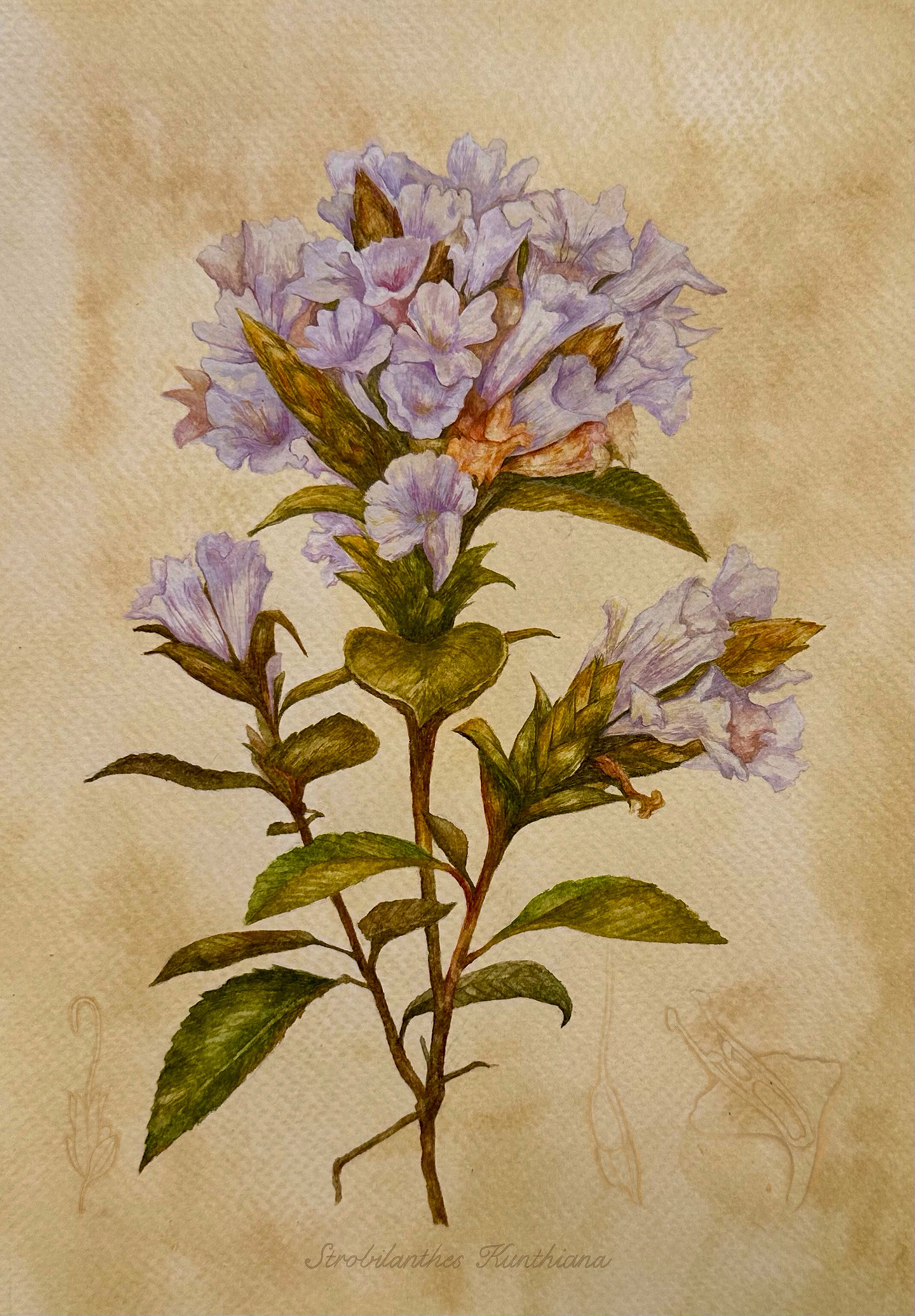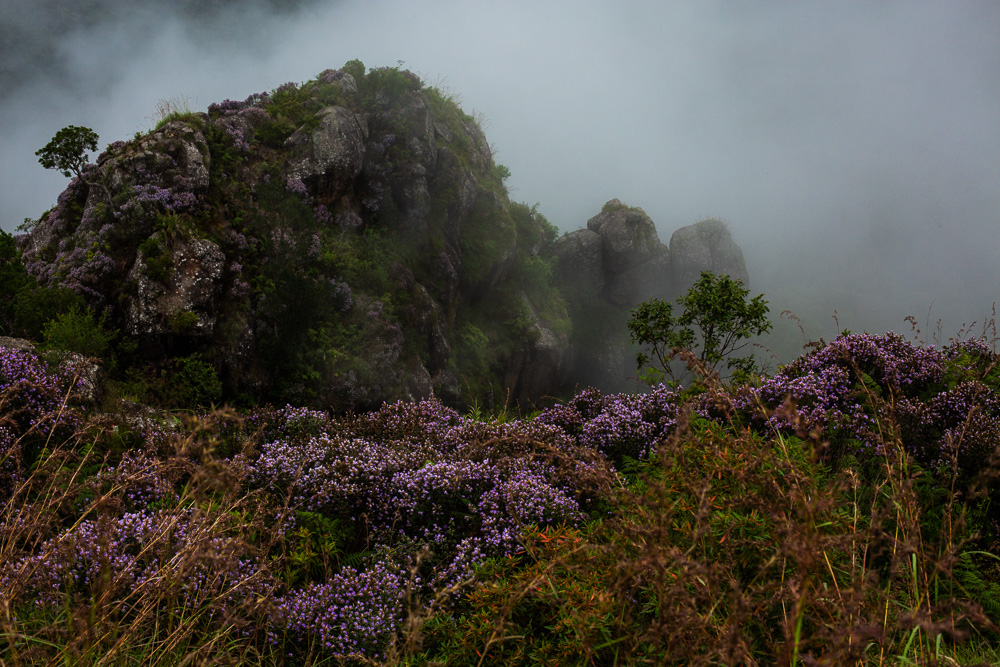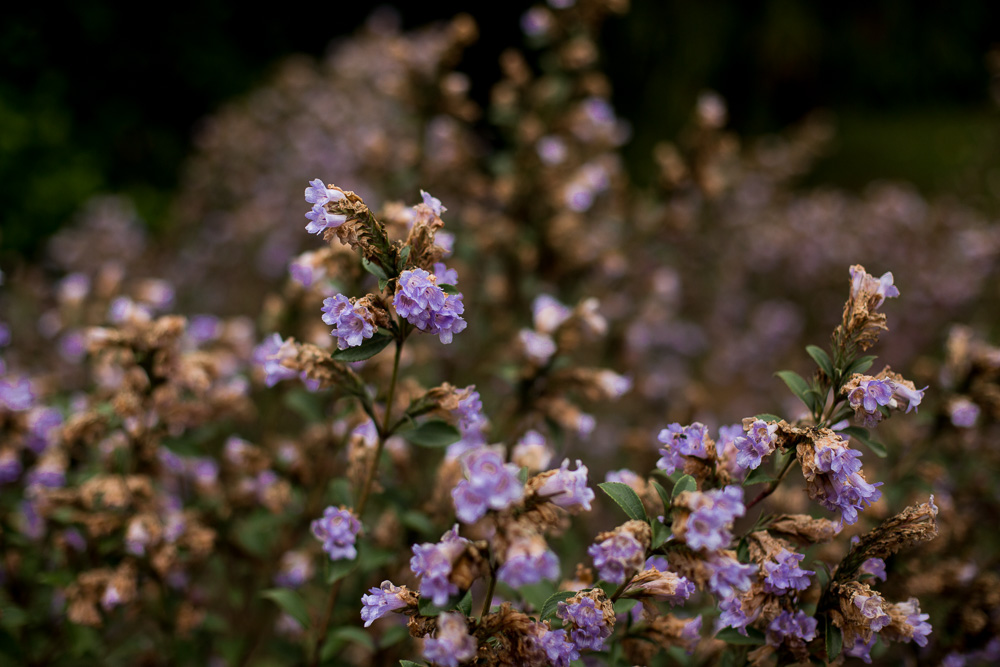Life in the Times of the Neelakurinji
In the Sangam poems of Tamil literature written in the 2nd century AD, the landscape is divided into five ecosystems called thinais, and high up on the mountainous Kurinji nilam, between verdant slopes and shola forests where birds and bees swoop into shimmering pools, is where the kurinji flower blooms every twelve years. According to legend, Murugan, the God of the mountains, put a garland of kurinji blossoms around the neck of Valli, a woman from the Muthuvan hill tribes of the Kurinji nilam. Even now, Muthuvan tribals calculate their age, birth and important events with the blossoming of the kurinji.
I moved with my family to Kodaikanal in the Palani Hills in 1987, roughly halfway between two mass flowerings. Eager to explore my picturesque surroundings, I set out each morning with my youngest daughter in tow. On a walk past Bombay Shola, a 25-acre indigenous forest on a hill behind our lake-side house, I spotted a few shrubs with clusters of bell-shaped flowers in shades of blue. I instantly recognised them as neelakurinji (Strobilanthes kunthiana), the fabled flower of the South-Western Ghats, that bloomed every twelve years. The kurinji bushes here were producing “rogue blooms,” flowers that appear out of season, for I knew I had missed the mass flowering in 1982, when entire hillsides turned blue as far as the eye could see. I wondered then, if we would be around in 1994 when the next mass flowering would take place.
I found some old books in the library of our century-old mission house, and scoured the pages for information about the little blue flower that is endemic to this region of the Western Ghats. A few faded kurinji blooms fell out as I turned the pages wondering which flowering year had produced these pressed blooms. The neelakurinji that gives the Nilgiris (blue mountains) its name, I read, grows in high-altitude grasslands across Coorg, Kerala and Tamil Nadu, where each region claims it as its own, it was the flower of every mountain community. The unique blooming patterns were first documented in 1858, the book informed me, and since then, there have been 15 mass flowerings. This is caused by a phenomenon called “semelparity,” which means the reproductive cycle of the flower triggers its synchronised blooming in a type of communal bonding. Semelparous species like the kurinji produce seed only once in a lifetime, then wither and die within a few months, having achieved their purpose: procreation. The new plant uses this time to amass reserves of nutrients to help it germinate for the next cycle – in twelve years.
In folk history and in poems and legend, the maturing and flowering of the kurinji is akin to young romantic love. I read this verse in a book of Sangam poetry, translated by AK Ramanujan, originally written 2000 years ago.
Bigger than earth, certainly
Higher than the sky
More unfathomable than the waters
Is this love for this man
Of the mountain slopes
Where the bees make rich honey
From the flowers of the Kurinji
That has such black stalks

The Kurinji made its first appearance in poems, legend, and folklore thousands of years before 1858, when it was officially documented and classified as Strobilanthes kunthiana. British botanist Robert Wight who initially studied this plant, identified over 20 species at the time. Eventually, 250 species would be documented, each with peculiarities and a life cycle all its own.
1994
It is the year of the Kurinji flowering across the Western Ghats. We are still in Kodaikanal, in the house by the lake; we have decided to stay on and build our own home on a property we owned out in the countryside. Alongside our plot was a steep hillside covered with kurinji shrubs, just turning blue. I counted no more than thirty shrubs that typically grow in shola grasslands but seemed to be thriving in this rocky terrain, sprouting in crevices between rocks and grassy patches with little soil. The plants clung to the mountainside, their stunted appearance mimicking shola trees. I walked over to examine the bell-shaped flowers, noting the violet-blue shades of the petals and the tinted buds waiting to unfurl. The plant is shorter than the grassland shrub, with reddish branches and large, coarse leaves. The flowers grow in clusters in a linear pattern, each flower an individual bell coated with fine hair – it has no fragrance; it is the sheer beauty of this mass flowering and the distinctive blue that attracts the bees, butterflies and birds that swoop down to drink the honey nectar. Bees and butterflies are attracted to certain hues and this serves a crucial biological function in the plant’s reproduction. Every 12 years, I imagined we would wake up and walk over to this sight, a cliff painted in azure hues.
One August weekend that year, we drove to Berijam Lake 15 Km away to see the mass flowering everyone was talking about. Out by the cliffs was a sea of iridescent blue, as spectacular as I had imagined it would be. Waves of kurinji flowers bent and swayed as a gentle breeze rustled about the grassland. A constant buzz reminded us that the bees were hard at work, collecting the rare kurinji-then. I imagined Wordsworth compiling a poem as he spotted a cloud of sky-blue kurinji, as enchanting as his beloved daffodils, “Across the grasslands, beyond the shola trees, fluttering and dancing in the breeze…”
This would also be my first sighting of the shola-grassland ecosystem that is typical of the South-Western Ghats. The shimmering expanse of grassland now tinted in blue, edged by the dense canopy of shola trees was a celebration of nature and only a unique mountain landscape such as this, with its combination of mist and rain could produce such wonders as the neelakurinji.
I had grown up in the city, and years after moving to this quiet hill station, I still had the occasional “fear of missing out” on important things that were happening there and in other parts of the world where life moved at a faster pace. Nelson Mandela had just been elected South Africa’s first black President this year, the Disney musical Lion King opened in theatres across the world and in Bombay, the city of my birth, everyone was talking about a proposed bridge across the sea that would connect the suburbs to the city in ten minutes. In our sleepy little hill-town, the newspaper was delivered every afternoon, and often, the paperman would skip a day and bring two issues together; the news was, of course, a few days old by then, which intensified the feeling of being “behind times.”
But a wondrous spectacle was unfolding right here, a short drive away from home, and I would have missed this, if circumstances had not brought us to this enchanted land where the Kurinji blooms.

Photo: Ramya Reddy, Soul of the Nilgiris
2006
Visitors from around the world have arrived in Kodaikanal (and other places in the Western Ghats), where the neelakurinji will put on a show this year. To commemorate the event, the Kerala government released a stamp and declared it the “Year of Kurinji.” Botanists, travel writers, and tourists gathered at coffee shops, clubs and the local library to discuss their own experiences and share stories and pictures. Scientists discussed variances and the implications of climate change, travel writers spoke about the best location and tourists compared shades of blue, the lack of fragrance, and the legends. Regular Kurinji watchers noted how the blooms are a lighter blue at the start of the blooming, and turn almost deep purple by the end of the flowering season.
“Why 12 years, why these long gaps?”
Someone wants to know. The explanation is simple, and a testament to some of nature’s wondrous ways. “Masting” is a survival mechanism in the natural world to conserve seeds that are coveted by birds and mammals. As annual pollination would endanger the kurinji, leaving it vulnerable, there is a long-dormant phase that helps it accumulate resources for the mass seeding that follows.
We moved into our new home in 1998, between the years of flowering and on certain days, clouds floated across the valley into our verandah, which overlooks layers of mist-shrouded mountains. Across the valley is another hillside with a patchwork of farms where I see matchstick figures move about, ploughing, tilling, and sowing, through the year. There are no trademark Kurinji hues on the opposite hill, perhaps explained by the farms that would have necessitated the clearing of land. Directly above, is the Kurinji Andavar temple dedicated to Murugan, the God of the hills, built in 1936. On the slopes beside us, the kurinji bushes bloomed bright for three months, hesitantly sending out the first early flowers, then exuberantly in full bloom, even as a freak storm battered the hillside.
This year, I see the mass flowering in Kerala, near Munnar, which reportedly has the highest concentration of kurinji plants. Kurinji followers insist this is where the flower blooms brighter, longer and in larger swathes. I could only compare it to what I had already seen in Kodaikanal, and indeed, the sheer expanse of Kurinji in bloom spread across 3000 hectares, is a magnificent sight.
Back home, I visited the Anglade Institute of Natural History, run by Jesuit priests who have been documenting the flora and fauna of the hills for over a hundred years. The environmentalist Jesuits kept a meticulous record of the blossoming in the PaIani hills, and a survey in the 1930s identified 250 species of the genus Strobilanthes, of which 72 were endemic to the Eastern Himalayas and the Western Ghats. All species belonging to this genus have an unusual flowering pattern ranging from an annual blooming cycle to longer intervals ranging from 6 or 8 to the longest – with Strobilanthes kunthiana at 12 years. Most of them bear similar flowers, although they differ in size, and have no fragrance. Plants that bloom after long intervals are called Plietesials, sharing characteristics like gregarious seeding, reproduction, blooming and death communally.
I visited a friend near Bombay Shola one morning to see if the kurinji shrubs still grew on the grassy knoll, which we had christened “Picnic Hill.” I took the mud road past the shola, spotting a brown wood owl and stopped to listen to the trilling of a Grey-breasted Laughingthrush as it flew about a giant tree fern. New houses had sprung up around the hill, and the kurinji shrubs had disappeared, possibly uprooted before construction or buried under the piles of rubble. The shola had miraculously survived, but we noticed a trail of broken bottles and chip packets; our hearts sank as we realised that the “tourists” had discovered this little gem of a forest in the middle of town.
2018
We planned a picnic to Berijam one weekend in September, hoping to see the last flush of kurinji blooms, but to our surprise, we were stopped at a checkpost and asked for our permits. Berijam Lake was our weekend destination for many years; we had picnicked on the banks, waded in the shallows, gone trout fishing in the streams that fed it, and once spotted (or imagined) a tiger in the sholas that edged it. Sometime between the flowerings, a forest check post had appeared here, and we, like other visitors, needed a permit to enter. This was directly a result of the worst predators of the forests, humans who threw trash, lit fires and chased animals around in jeeps or motorbikes, pretending they were on a safari.
On our walks to Bombay Shola, past the old graveyard, the shola birds still sang in high branches, and bushy-tailed squirrels ran up and down the gnarled trunks. We learned to look out for the familiar black hump, the white socks and the harrumph of a recent arrival in town – bison. Locally called “kaatu maadu,” these wild cousins of the native cows had migrated to the town centre, where they would be seen ambling down country roads into gardens, past the town’s favourite bakery and into the bus stand. It was a mystery why they had moved to these crowded human spaces with negligible grass and water sources to sustain them. Perhaps it was the growing mounds of food waste from restaurants thrown into garbage dumps, the salty chip and noodle packets that attracted them, for bison have a craving for salt. They seemed to be sending a message – the grasslands where they had grazed for years were shrinking, water was scarce, and they were here for better prospects. Interestingly, both Kurinji and kaatu maadu have a positive impact on grasslands. As the plant dies, it opens up the soil, encouraging regrowth, while the bison disperse seeds and dung in the grasslands as they ruminate. What would happen to the grasslands, if both species disappeared?
The indigenous Paliyan tribe, who calculate their age according to the kurinji blooming are the traditional honey hunters of the Palani Hills. At the end of the flowering season, the precious kurinji honey is harvested using a bow and arrow to puncture swollen hives high up on the trees. A container is placed below to collect the liquid gold – which is what the tribals called it – for it fetched a good price in the market. We bought a bottle of Kurinji-then from the Cooperative store in the bazaar where the rare honey is available for “as long as stocks last.” We had our first taste of Kurinji-then, known for its medicinal properties, the bitter-sweet flavours, lingering on our tongues long after. This was the year I missed the mass flowering, but I saw the kurinji blooming in patches all over town, fragments of wilderness that still held a stretch of grass.
Now…
Two years after the 2018 flowering subsided, and the first wave of Covid hit the world in 2020, the hillside by our home was engulfed by fire. A farmer in the valley below had used the slash-and-burn method to clear his land on a hot summer morning as rain was imminent. A blazing twig started a fire line that crept upwards, torching the dry grass, and soon the entire hillside was ablaze. Neighbours rushed over to help as we struggled to contain the fire before it spread to our home – a few feet away. The fire engine eventually reached us with insufficient water to douse the fire, and our supply of precious rainwater was soon depleted. The next morning, I walked over to a charred landscape covered with thick grey ash. Everything was burnt to the ground: the wild lemongrass, ground orchids and tibouchina and the lone Rhododendron tree on the edge of the cliff, which formed a grim outline against the clear blue sky; the Kurinji, which I had read was “fire-resistant” had burnt down to the roots.
A month later, it rained, and the first blades of grass appeared, along with a peep of wild orchids and lemongrass. Fire sanctifies the land and prepares it for new birth, and I knew the kurinji would emerge too, for the seeds were hidden deep in the crevices, waiting.
During the Covid years, I noticed the patchwork of farms across the valley slowly disappearing; a long tarred road snaked down the hillside past a sprawling new resort, and every bit of vegetation was cleared. The verdant hillside where the Kurinji once bloomed on little grassy plateaus, had given way to farms, and now to vacation homes. But this was happening everywhere. Vast tracts of grasslands were lost to monoculture plantations during colonial times, then to roadways, railway tracks, large hydroelectric projects, tourism, human habitation and farmlands. Recent satellite imagery of the Western Ghats over 40 years revealed the harsh reality: grasslands have reduced up to 66 per cent, surviving in many areas as fragmented patches.
The Kurinji spends an entire lifetime flowering and fruiting in its natural habitat: the mist-shrouded grasslands of the Western Ghats, its only home on the planet. Any disturbance to this ecosystem has an adverse effect on the pollination cycle, which determines the long-awaited blooming season. This endemic flower of the Southern mountains has now become an environmental mascot, representing a unique ecosystem that needs protection. The Kurinji shares its home with a range of flora and fauna, some waiting to be discovered and others, endangered species on the verge of extinction. The shola-rainforest-grassland, which acts like a sponge, retains monsoon rains and is the source of many rivers supplying water to the parched plains of South India. The future of these hills is entwined with its indigenous flora and fauna: the Kurinji, the grasslands, moss and lichen, the Tahr and the bison, the Nilgiri pine marten, the solaikuruvi and honey bees, every life form that contributes to this circle of life. The preservation of Kurinji nilam is essentially the protection of an entire ecosystem.
There is a sense of something larger, infinite, for these ancient flowers have been flowering in a continuous cycle of life and death for thousands of years. If nature has its way, these mysterious rhythms of the natural world will continue for thousands more. For now, there is the blooming in 2030 to look forward to.

Photo: Ramya Reddy
————————————
BOX
Documented Mass Blooming across the years: 1838, 1850, 1862, 1874, 1886, 1898, 1910, 1922, 1934, 1946, 1958, 1970, 1982, 1994, 2006 and 2018.
The next mass flowering will be in 2030


